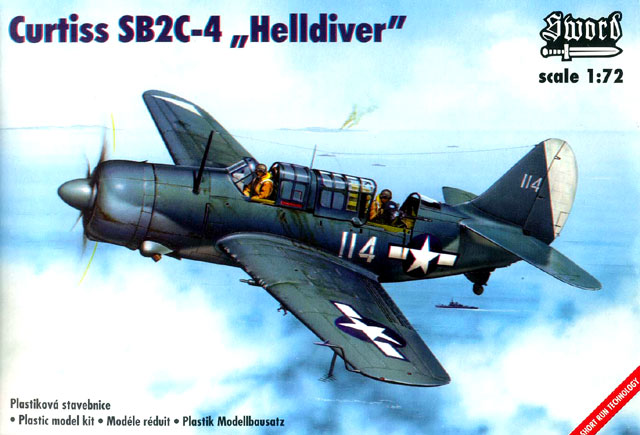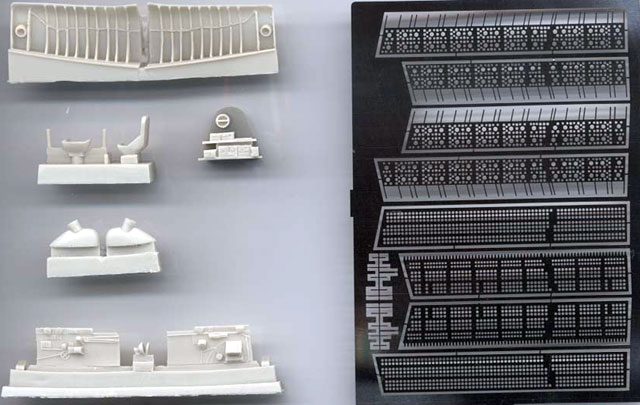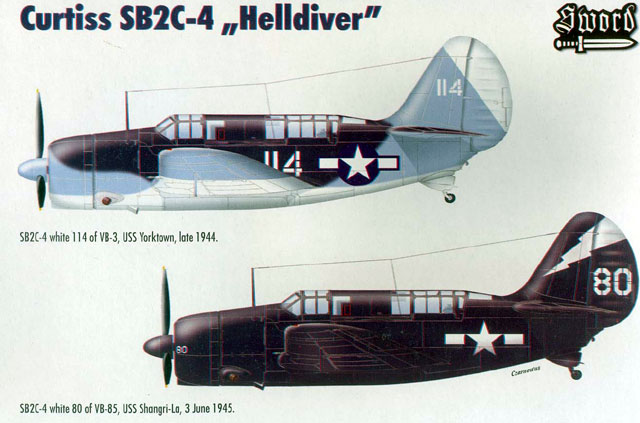|
Curtiss SB2C-4
"Helldiver"

Sword
S u m m a r y
|
| Catalogue
Number: |
SW 72008 |
| Scale: |
1/72 |
| Contents and Media: |
38 "limited run" injection
molded parts in grey plastic; 14 resin parts; 2 vacform canopies; 2
small sheets of decal markings; 1 sheet of photoetch parts, 6 pages of
construction and painting instructions. |
| Price: |
USD ? from
www.squadron.com |
| Review Type: |
FirstLook |
| Advantages: |
Popular US WWII subject; Nicely
engraved panel detail; etched parts and resin pieces; spare canopy
supplied |
| Disadvantages: |
Large injection molding gates on
parts |
| Recommendation: |
Recommended for intermediate and
experienced modellers. |
Reviewed by Dale Smith

Sword's 1/72 scale SB2D-4 Helldiver is available online from
Squadron.com
Affectionately, or sometimes not so affectionately known in the early
days as the 'Beast', the Curtiss SB2C was developed in 1938 to meet a US
Navy dive bomber specification. The US Navy subsequently ordered 370
airframes powered by the proven R-2800 Pratt & Whitney engine.
Many difficulties were encountered in development and production and as
a result of these problems, and the time required to correct them, the
first SB2C-1 aircraft were not delivered to the US Navy squadrons until
December 1942. The type saw combat for the first time almost a year later
in November 1943 over Rabaul, New Guinea.
As the earlier problems were overcome, a newer version specified as the
SB2C-3 was brought online in 1944 with improvements that included a more
powerful engine, a four bladed propellor and a larger payload. Further
improvements resulted in the SB2C-4 that included racks for rockets or
larger bombs and better handling characteristics. 5516 airframes were
eventually delivered to the US Navy, with the type also serving with the
French, Italian and Portugese navies. The Greek and Thai airforces also
used the aircraft after WWII.
The kit is supplied in a light grey ' limited production' style of
plastic typical of manufacturers in the Czech Republic such as Sword and
MPM. The injection gates on the parts from the molding process are quite
thick, so careful separation and cleaning up of all the parts will be
required. 2 vacformed canopies are supplied, so all you modellers out
there that cringe at the thought of vac canopies, can rest easy in the
knowledge that if you do muck one up, you have one more chance! Both of my
canopies were nicely formed with no deformities or blemishes.
Details on the main kit parts such as the wings and fuselage is nicely
engraved with locating lugs and holes supplied to locate the horizontal
tailplanes and the wingtip pieces. No location positions are supplied for
the mainplane to fuselage join, so care and judicious use of glue and
alignment will be needed here. One or two of the parts had small molding
imperfections on their surfaces, but nothing a swipe with the sanding
stick will not fix. Flash on the parts is also minimal considering the
manufacturing process.
Click on the thumbnails
below to view larger images:
14 resin pieces are supplied that cover the wheelwells, cockpit
sidewalls, exhaust manifolds, crew seats, gunsight, rudder pedals, radio
operator/rear gunners position instrument panel and wing gun barrels. All
of the resin parts are nicely formed with no air bubbles or deformities.
A small stainless fret is supplied that contains the dive brakes and
some small aerials. The details on these small parts is excellent and has
to be seen to be appreciated. The etched details are done by Eduard so the
quality of these items is assured.

I was unable to locate any line drawings in my reference library, but
stated measurements in a number of publications seem to tie up well with
what measurements I took freehand then converted to 1/72 scale. The kit
may be about a millimeter short in length, but most of us apart from the
purists can live with that. It may have been my freehand measuring that
let me down here as well. The molding also captures the bulky fuselage
cross section.
2 marking options are supplied. The first is for an aircraft 'White
114' of VB-3, USS Yorktown in late 1944 in a Sea Blue, Intermediate Blue
and White scheme. The second is for an aircraft of VB-85 'White 80' on the
USS Shangri-La in June, 1945 in an overall Glossy Sea Blue scheme.

The
decals are printed by 'Techmod' and have good colour density and register.
Colour painting instructions are called out during construction with
references given to ANA and FS numbers.
This model looks like it will build into a nice replica of the
'Helldiver'. Some patience when cleaning up the parts and test fitting
before application of glue will work in the builders favour and a nice
model should result.
Recommended to more experienced modellers that are used to building
multi media kits.
Many thanks to Squadron Mail Order for supplying the
review sample
Review Copyright © 2002 by
Dale Smith
This Page Created on 03 April, 2002
Last updated
22 July, 2003
Back to
HyperScale Main Page
Back to
Reviews Page
|
Home | What's
New | Features
| Gallery |
Reviews | Reference
| Forum
| Search